The Rise of Flexible Work: Exploring the World of Short Shift Employment
Related Articles: The Rise of Flexible Work: Exploring the World of Short Shift Employment
Introduction
With enthusiasm, let’s navigate through the intriguing topic related to The Rise of Flexible Work: Exploring the World of Short Shift Employment. Let’s weave interesting information and offer fresh perspectives to the readers.
Table of Content
The Rise of Flexible Work: Exploring the World of Short Shift Employment

The traditional nine-to-five work model is increasingly being challenged by the demands of a modern workforce seeking flexibility and work-life balance. In this context, the emergence of jobs with shorter shifts, particularly those lasting four hours, has become a significant trend, offering a compelling alternative to traditional employment structures. This article delves into the diverse landscape of these short-shift jobs, exploring their benefits, challenges, and the industries where they are most prevalent.
Understanding the Appeal of Short Shifts
Jobs with four-hour shifts, often referred to as "half-day" or "split-shift" positions, offer a unique blend of flexibility and opportunity. They cater to a wide range of individuals seeking to:
- Balance Work and Life: Short shifts allow for a more balanced lifestyle, providing time for personal commitments, family responsibilities, education, or other pursuits. This flexibility is particularly attractive to individuals with childcare responsibilities, students, or those with health concerns.
- Increase Earnings: While individual shifts may be shorter, the ability to work multiple shifts throughout the day or week can lead to higher overall earnings. This is especially relevant for individuals seeking to supplement their income or maximize their earnings potential.
- Gain Experience and Skills: Short shifts can serve as a stepping stone for individuals seeking to enter new industries or gain experience in specific roles. They can be a valuable tool for career exploration and professional development.
- Enjoy Greater Autonomy: Short shifts often offer a higher degree of autonomy, as individuals can choose their preferred shift times and days, allowing for greater control over their work schedule.
Industries Embracing Short Shifts
The adoption of short shifts is gaining traction across various industries, driven by factors such as:
- Retail and Hospitality: The service industry, with its inherent need for flexible staffing, is a prime example of where short shifts thrive. Businesses like restaurants, cafes, convenience stores, and retail outlets often rely on part-time employees working short shifts to manage peak periods and customer demands.
- Healthcare: The healthcare sector, with its round-the-clock operations, has long embraced short shifts. Nurses, caregivers, and other healthcare professionals often work shorter shifts to accommodate patient needs and maintain a sustainable work-life balance.
- Transportation and Logistics: The transportation and logistics industry, with its cyclical nature and fluctuating demand, often utilizes short shifts for drivers, delivery personnel, and warehouse workers.
- Customer Service and Call Centers: These industries, characterized by high call volumes and varying customer needs, often employ short-shift workers to provide consistent service coverage throughout the day and night.
- Freelancing and Gig Economy: The rise of the gig economy has further fueled the demand for short shifts, as individuals can choose to work on projects or tasks for specific periods, offering flexibility and control over their schedules.
Benefits of Short Shifts for Employers
The adoption of short shifts also brings several advantages for employers:
- Increased Flexibility: Short shifts allow employers to manage staffing needs effectively by adjusting staffing levels to meet fluctuating demand. This flexibility is crucial for businesses operating in industries with seasonal peaks or unpredictable customer traffic.
- Reduced Labor Costs: While short shifts may require more frequent staffing changes, they can also reduce overall labor costs by minimizing overtime pay and maximizing the utilization of part-time workers.
- Enhanced Productivity: Research suggests that shorter shifts can lead to increased employee productivity and engagement. This is attributed to reduced fatigue and improved focus during shorter work periods.
- Improved Employee Retention: Offering flexible work arrangements, including short shifts, can contribute to higher employee satisfaction and retention. This is especially relevant in competitive job markets where attracting and retaining skilled employees is crucial.
Challenges of Short Shifts
Despite their benefits, short shifts also present challenges for both employers and employees:
- Coordination and Communication: Managing a workforce of individuals working short shifts requires effective coordination and communication to ensure seamless operations and efficient task allocation.
- Training and Onboarding: Frequent turnover among short-shift workers can necessitate ongoing training and onboarding processes, which can be time-consuming and costly.
- Employee Scheduling: Creating a balanced and efficient schedule for a workforce with varying shift preferences can be complex, especially when considering factors like peak periods and employee availability.
- Limited Benefits and Security: Part-time employees working short shifts often have limited access to benefits and job security compared to full-time employees.
FAQs on Jobs with Short Shifts
Q: What are some common examples of jobs with four-hour shifts?
A: Common examples include retail associates, customer service representatives, food service workers, delivery drivers, nurses, caregivers, and freelance writers.
Q: How are short shifts typically structured?
A: Short shifts can be structured in various ways, including:
- Split Shifts: Two separate four-hour shifts within a single day, often with a break in between.
- Flexible Shifts: Employees can choose their preferred shift times and days, allowing for greater autonomy.
- Rotating Shifts: Employees rotate through different shift times to ensure consistent coverage.
Q: What are the potential drawbacks of working short shifts?
A: Potential drawbacks include:
- Lower overall income: While multiple shifts can increase earnings, a single short shift may result in lower pay compared to a full-time position.
- Limited benefits: Part-time employees working short shifts often have limited access to benefits such as health insurance, paid time off, and retirement plans.
- Job insecurity: Part-time positions with short shifts can be less secure than full-time positions, as employers may be more likely to adjust staffing levels based on fluctuating demand.
Q: How can I find jobs with short shifts?
A: To find jobs with short shifts, consider the following:
- Online job boards: Websites like Indeed, Monster, and CareerBuilder often list part-time positions with short shifts.
- Company websites: Many companies advertise part-time positions directly on their websites.
- Local businesses: Contact businesses in your area, particularly those in retail, hospitality, healthcare, or transportation, to inquire about part-time opportunities.
- Networking: Reach out to your network of friends, family, and former colleagues to see if they are aware of any open positions with short shifts.
Tips for Success in Short Shift Jobs
- Be proactive: Take initiative and communicate your availability and willingness to work multiple shifts.
- Be reliable and punctual: Consistency and punctuality are crucial for maintaining a positive reputation and ensuring smooth operations.
- Be flexible and adaptable: Be prepared to adjust your schedule and responsibilities as needed to meet the demands of the job.
- Develop strong communication skills: Effective communication with colleagues and supervisors is essential for coordinating tasks and resolving issues.
- Stay organized and efficient: Utilize time management techniques to maximize productivity during short shifts.
Conclusion
Jobs with short shifts are increasingly becoming a viable option for individuals seeking flexibility, work-life balance, and opportunities for career exploration. While they present certain challenges, the benefits of these positions – including greater autonomy, increased earnings potential, and improved work-life balance – make them a compelling alternative to traditional employment structures. As the demand for flexible work arrangements continues to grow, the prevalence of short shifts is likely to increase, offering a wider range of options for individuals seeking fulfilling and sustainable employment opportunities.

![The Rise of Flexible Working [Infographic] — Ridiculously Efficient](https://www.ridiculouslyefficient.com/content/images/content/v1/56ad0eb962cd942d9e46f366/1454986459474-VJBUTONX7TF6TKMW0IFM/the-rise-of-flexible-work_53034543dab3a_w1500.jpg)





Closure
Thus, we hope this article has provided valuable insights into The Rise of Flexible Work: Exploring the World of Short Shift Employment. We appreciate your attention to our article. See you in our next article!

